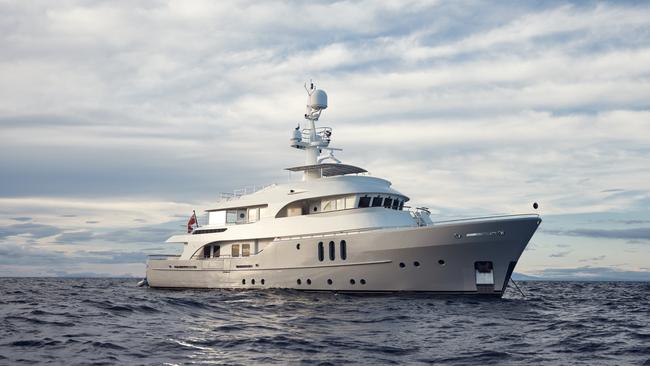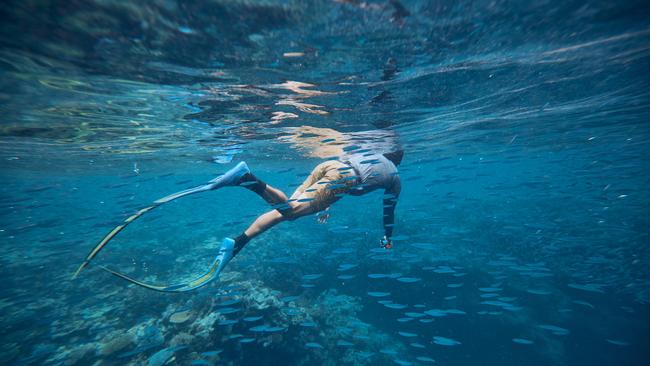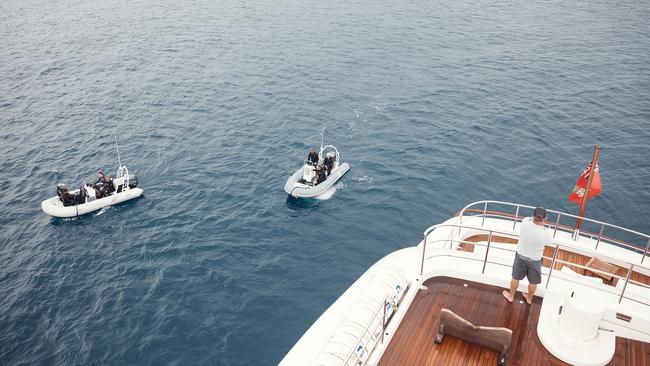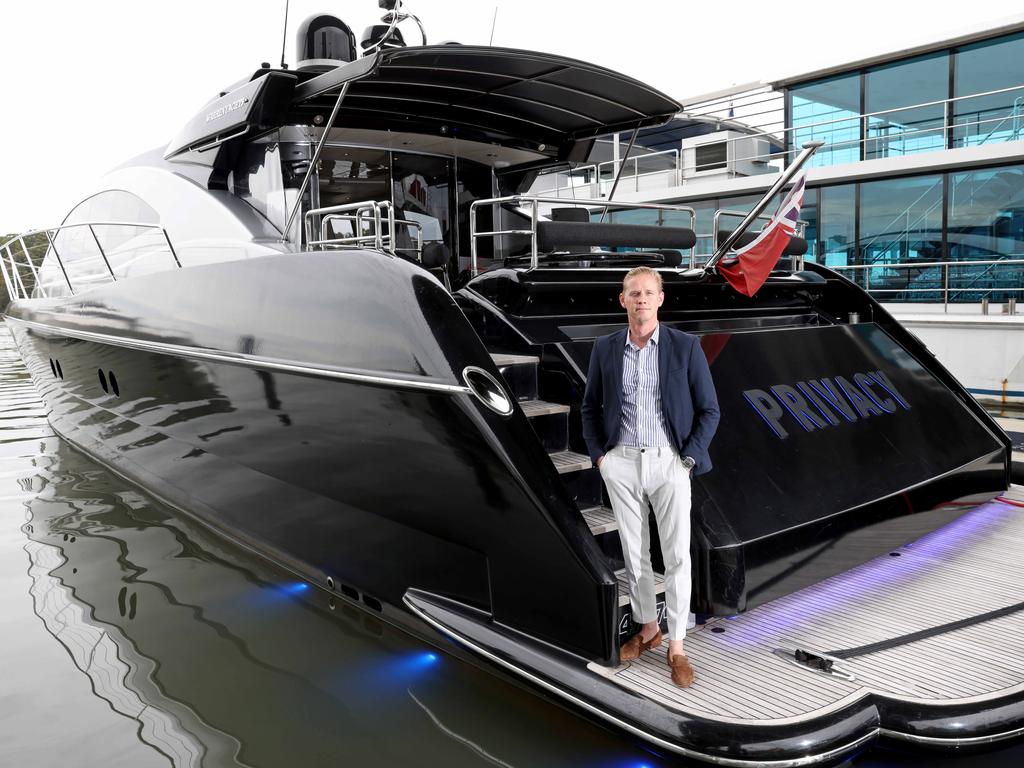Luxury plus science equals a good time by all on board the Beluga
Social science is spreading in our waters thanks to an eco-activist group and their superyacht-enabled supporters.

The difference between a grimace and a smile is just a blip of the lip, and yet the effort to stop the latter slipping to the former can be exhausting. So much so that you can sometimes see the polite, sub-surface battle taking place in someone’s eyes.
Nicole Senn is an intensely committed conservationist who doesn’t so much work at Citizens for the Great Barrier Reef as live its eco-focused principles. She’s lovely, bubbly, and butter wouldn’t melt in her mouth, because she’s a vegan.
Mark La Brooy is also keen on conservation, a climate warrior and chef extraordinaire – he’s co-founder of Three Blue Ducks restaurant group – who also likes to get up close to some of the spectacularly sized fish on the Great Barrier Reef and skewer them with a spear gun.
La Brooy, 42, who vibrates the kind of positivity that makes it difficult to grimace at him, has just popped his hairy head out of the implausibly warm water after conducting a survey of a section of our imperilled reef, surely one of the most enjoyable jobs in science as it involves swimming over swathes of shoals of immense beauty and taking multiple photos of it with a GoPro camera, every five flips of your flippers.
And now he’d like someone to throw him his laughably large spear gun, because he’s seen a tasty coral trout the size of a garbage-bin lid.
Everyone else on our citizen-scientist expedition, which is based on the 35m superyacht, Beluga, lent to us for free by rich lister Chris Ellis, (but normally yours to charter for $27,000 a day) is trying not to look at Senn and her rapidly thinning smile, because we’re not vegans, and we’d really like La Brooy to cook for us again.
Obviously every single minute spent on board a staggeringly luxurious ship such as Beluga – with its seven full-time staff, including a cocktail mixologist, a dining room that is eight metres wide, and a hot tub on the top deck – is a joy, and yet tasting the fresh fish that Mark had caught on a line the day before, crisply coiffed in a vodka and beer batter he’d whipped up, was an unforgettable experience.
But I digress, we’re here to work, and hopefully help save the world.

Citizens of the Great Barrier Reef (CGBR) was established in 2017, growing out of a crisis meeting called after a second successive coral-bleaching incident, one that had headlines about the reef’s imminent death breaking the internet.
CGBR’s chief executive, Andy Ridley, a lifelong conservationist and WWF veteran who was the bright spark behind turning all the lights off for Earth Hour (a campaign he created in Sydney in 2007 that grew to more than 5000 cities worldwide) didn’t buy it.
“I love the reef, I’d worked on it before, but I was reading about it and thinking, ‘Hang on, there’s just no way the whole reef is fully dead’, but that was the story, and I could see why it was being spread that way,” Ridley recalls.
He’s not talking down the size of the problem, of course. Indeed it’s size that is part of the problem with which he’s attempting to grapple.
If the Great Barrier Reef was all grass, it would cover 70 million football fields, which is too large a number to imagine, so try and picture an area that’s the size of Germany, or just slightly larger than Italy. It is made up of more than 4000 individual reefs, stretching along an area of coastline, which, at 2300km, is longer than the US west coast.
It is, in short, impossible to know just how sick the whole reef is, because we only regularly survey about five per cent of it a year. Staggeringly, Ridley says, 40 per cent of it has never been surveyed. In essence, we are trying to work out what’s wrong with an elephant by carefully examining its tail, and two of its feet.
Ridley could see that a lot more reef needed to be covered, but doing so would be prohibitively expensive because boats, even those far smaller than Beluga, are not cheap to run. His leap of imagination was to ask people to help, by giving his team boat time for free, so that CGBR could establish an annual reef census, on an unprecedented scale, by creating “a motley flotilla of boats, everything from tug boats to superyachts”.
This meant dive boats full of tourists could help, superyacht charters, yachties, spear fishers. In short, citizens, conducting citizen science, all for the greater good.
“There was a clear need to do broad-scale reconnaissance, to help us identity key-source reefs – the healthy ones that can reboot those around them – and to get a vision of what’s happening on a yearly basis,” Ridley explains.
“The way we look at it is it’s almost a pilot project for how we could do massively scaled-up conservation, with a big reliance on technology and an even bigger reliance on people giving their time.

“What conservation has historically done is said, ‘Give us your money and we’ll go and do it’. This model is different, it still needs money but not as much, it’s more about ‘We want your time, and we want your brain and we’d like your boat’.
“So our list of demands is quite high, but people seem to want to be more legitimately part of the effort, rather than just handing over cash.”
Incredibly, Ridley’s idea worked – in large part thanks to his incredible ability to convince people to do things for free. The first Great Reef Census, in 2020, covered 115 reefs using 31 boats, including Beluga and produced 14,000 images. In 2021, the number of boats more than doubled to 65, a total of 315 reefs were surveyed and more than 45,000 digital photos were uploaded to a website where they could be examined by scientists to get a better idea, not only of where bleaching was happening, but where the infamous crown-of-thorns starfish were doing damage.
Previously, a dozen crown-of-thorns-focused boats would patrol the reef each year, looking for these “cockroaches of the sea”, as Senn colourfully describes them, and killing them by injecting them with a shot of vinegar. Thanks to the census, those boats are now wasting far less time trying to find them, because they know where to go.
We were gathered on Beluga, GoPro cameras in hand, to complete the final stage of Great Reef Census 3 (which covered more than 630 reefs, on 95 boats and produced 60,000 images). The project has now grown so large that computer company Dell created a special AI program that can identify different kinds of coral from the images, to help create maps of the reef.
All of this was explained to us on the distractingly lovely deck of Beluga before we set off for three full days of science (interspersed with soirees and sashaying on our superyacht).
It was at this point that I asked the irrepressible La Brooy if he could help prevent me from being killed or drowned in the next few days.
While I am often described as having the sylph-like strides of a human-fox hybrid on dry land, I quickly resemble a fish in distress when dropped in deep water. This meant I had to suffer the ignominy of asking the salt-caked sea dogs organising our gear for a pool noodle, to ensure I didn’t sink to the bottom and badly damage some vital coral.
La Brooy, on the other hand, looks like Jason Momoa’s Aquaman would, if you could somehow stick him with a series of pins and let most of the air out of his unrealistically engorged muscles.
Beneath the water he moves like a cheetah might, if it grew enormous flippers. He also pulls off the impressive trick of appearing not to need oxygen, thanks to years of free-diving, and would thus regularly disappear five or even 10 metres beneath me to take his far superior survey images.
Even with my shallower approach, however, I’m happy to report that we really did see some staggeringly vibrant reefs, teeming with fish, turtles, sharks and giant clams with lips so bright blue you wonder how they could be so cold in such warm water (it was about 31°C).
Surely there are few places on the planet where a few millimetres can make such a vast difference to your outlook. Bobbing with your chin in the water, the horizon is a lolling, beach-towel blue with hints of lime cordial. Tilt your mask into the water, however, and it’s like a separate, sci-fi spectacular. Towers and fields of coral tumble into each other with what feels like thousands upon millions of fish, some the size of Rice Bubbles, others like pillows, all of them flushed with flares of colour that seem so vibrant as to be unnecessary. It’s as if whatever gods created this underwater wonderland spilled a factory full of glow sticks on it and decided that, surprisingly, it looked pretty good.
-
“What conservation has historically done is said, ‘Give us your money and we’ll go and do it’. This model is different, it still needs money but not as much, it’s more about ‘We want your time, and we want your brain and we’d like your boat’ ”
-
Even La Brooy seems as blown away as I feel, at times, as he splashes by me like a seal. If he wasn’t so disarmingly affable, absent of ego and constantly cracking into smiles, I could have grown to hate him. Mind you, as soon as he cooked something for me, particularly his sashimi of goldband snapper with ponzu sauce, all would have been forgiven anyway.
While his skill set includes diving, spear fishing, bow and rifle hunting (hearing him describe all those really made Senn’s day) and the ability to eat enough for three people while still boasting a flat stomach, La Brooy was clearly put on this planet to bless the taste buds of others. The man can cook. But why was he here, doing science, rather in a kitchen?
“One of the biggest influences I can bring to the table with the reef census is I am quite connected within the spear-fishing community, I’ve been a spearo for more than 25 years, and it turns out that that demographic quite literally has the best eyes on the reef, in the furthest reaches,” he explains.
“We want to go to the areas where there’s a lot of fish activity or shark activity, where regular people won’t go and snorkel, so getting us involved in the census is going to increase the area it can cover.”
La Brooy has been coming to the reef for years and says he’s noticed the increasing creep of our world into the underwater one.
“It’s all interconnected, and I’ve seen coral bleaching, I’ve seen those big graveyards of coral, and I think the more you can showcase and engage with your environment, the more you turn people into advocates for protecting it,” he says, ire rising.
“But I think if we continue to live in this world, where we just like live in our screens, well, then we don’t give a shit about things like the reef, because we’re not looking at it. If it’s not on a screen, we don’t care.”
Amusingly, after several misfiring attempts, the great white spear-fisherman didn’t skewer a single living thing, a result that might have slightly, quietly pleased our vegan colleague.
If chartering Beluga to do citizen science seems a little extreme, you’re wrong, it’s perfect, but there are other options, like Aroona, a 22m yacht that’s also donated its resources to CGBR and the census, thanks to skipper Ross Miller.
“Over 20 years up here, we’re always exploring new reefs but now we’re not just doing it to see what it’s like, through the census we’re doing research for the scientists that help manage it,” Miller enthuses.
“I’ve got some clients who’ve been coming up here for six years, they’re not scientists but they’re just passionate about understanding the reef and they’ve come up to be part of the census for the past two years, and probably 90 per cent of the new sites we went to were looking fantastic.
“A lot of our clients these days feel like they don’t want to be just on holiday, they want to be supporting something. It’s this kind of ‘meaningful tourism’ that really adds an extra layer to their experience.”
This story appears in the July issue of WISH, out on Friday July 7 with The Australian.


